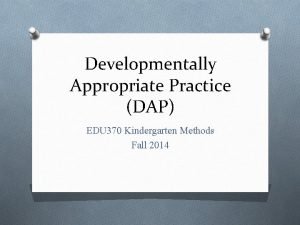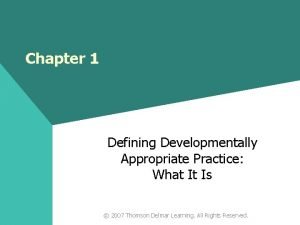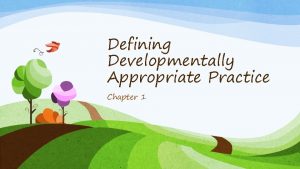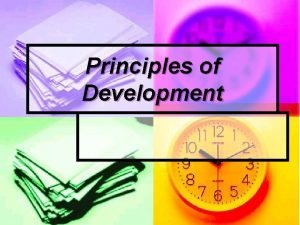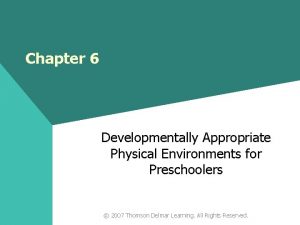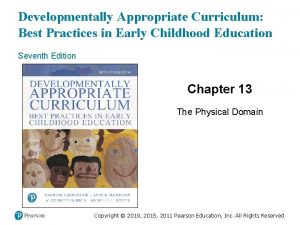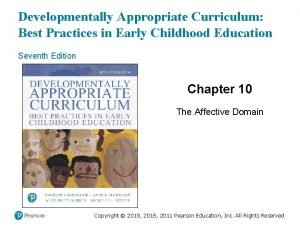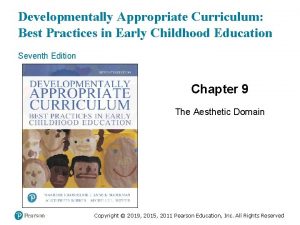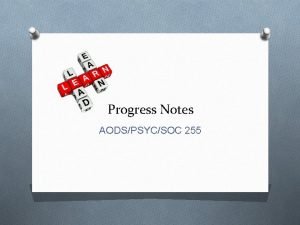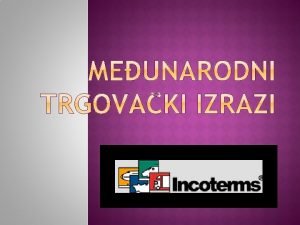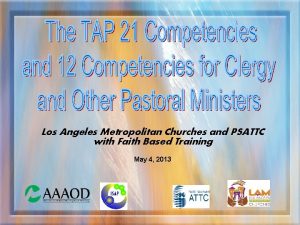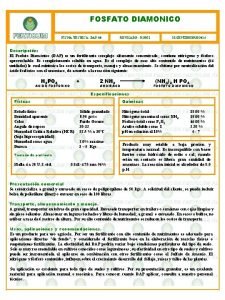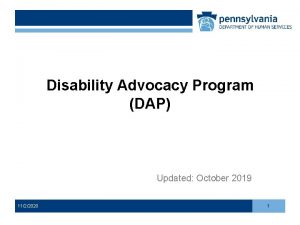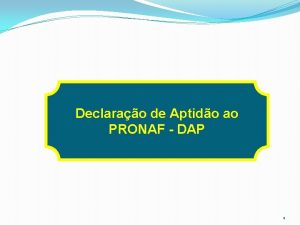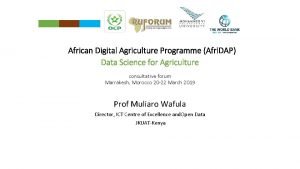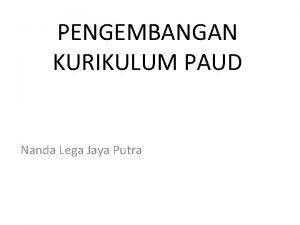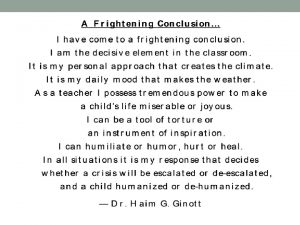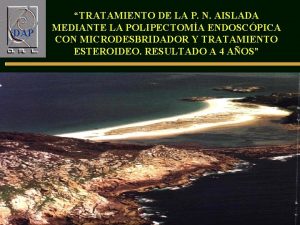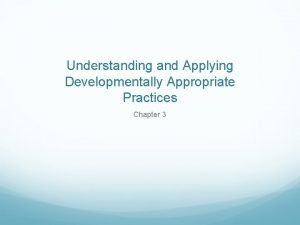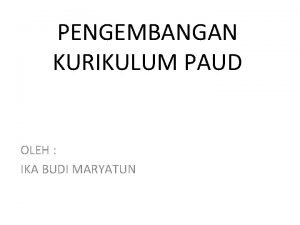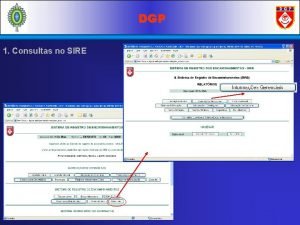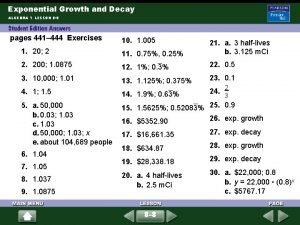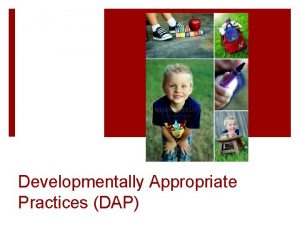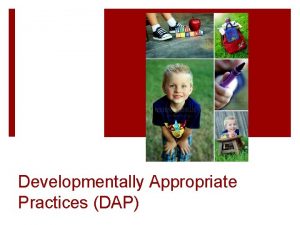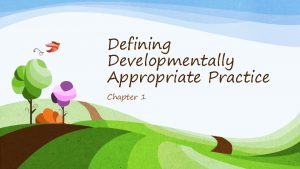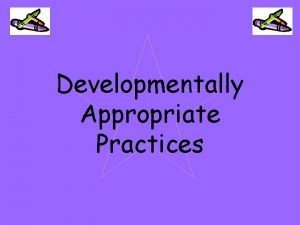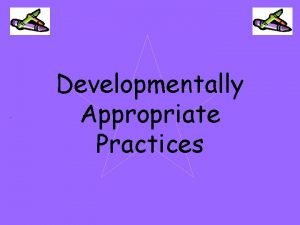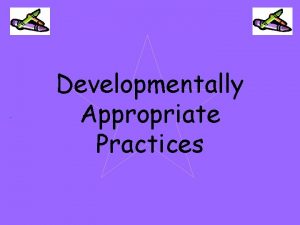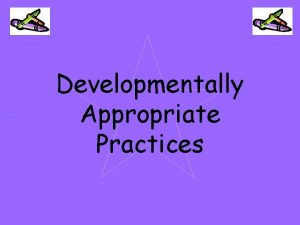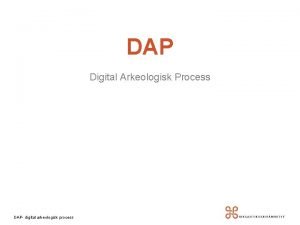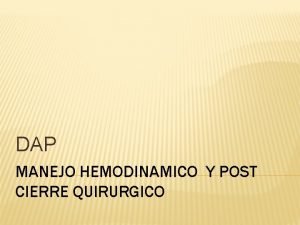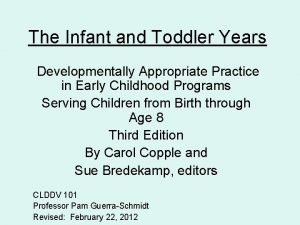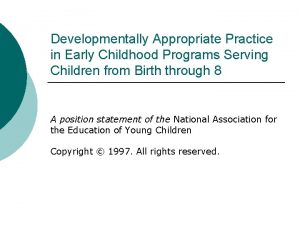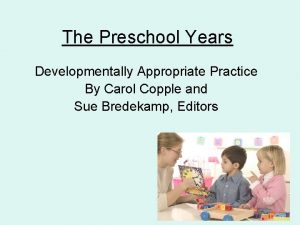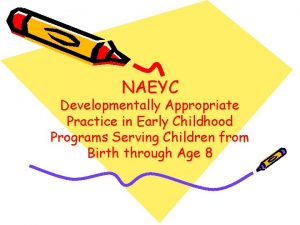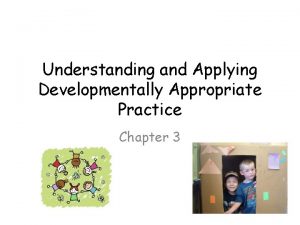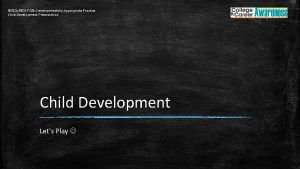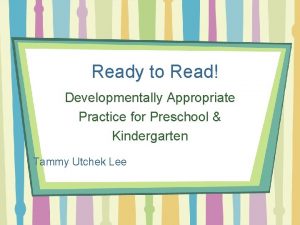Exploring Developmentally Appropriate Practice DAP in K3 Social






















- Slides: 22

Exploring Developmentally Appropriate Practice (DAP) in K-3 Social Studies February 25, 2017 Use the index cards on the table to make a quick sketch of you in your classroom with your students during a Social Studies lesson

Welcome and Introductions • Share around the room: o Who are you? o Where/ What grade level do you teach? o Two words that describe your illustration (NOT words about the artwork, but words around the content)

What is the purpose of Social Studies? Helping “young children make informed and reasoned decisions for the public good as citizens of a culturally diverse democratic society in an interdependent world. ” NCSS 2001

What is our purpose today? To experience, inform, and discuss DAP and curricular choices for K-3 classrooms

Best Practices in Primary School What do we Know • Balance children’s need for focused instruction with their need to build on what they already know • Provide beneficial concrete, hands on experiences • Make necessary visible connections, especially across subjects • Allow for integration of curriculum which fosters connections and is fun for kids • Provide explanations, illustrative information, direct instruction on new words, concepts or events, and opportunities to practice new skills

What is a teacher’s role in Developmentally Appropriate Practice (DAP)? (NAEYC) 1. Creating a Caring Community of Learners – ENVIRONMENT/RELATIONSHIPS are key 2. Teaching to Enhance development and learning – TEACHER TOOLBOX/STRATEGIES (how of lessons) 3. Planning a curriculum to achieve important Goals CONTENT – Rigorous/ interesting/ standards based 4. Assessing children’s development and learning – APPROPRIATELY Performance/Project based 5. Establishing reciprocal relationships with families – THROUGHOUT, responsive

What can it look like?

What did you see/hear/notice? • At your tables, please note those things that were more traditional vs less traditional? • Identify those things that you already incorporate • Identify struggles/barriers you might have with this type of model • Share a most important idea or comment with the group

What makes this lesson DAP? • Using a collaborative inquiry process (around a Social Studies theme) ? s i th • Teachers guide students to construct a compelling important question and in developing supportive questions which help arrive at the knowledge to answer the compelling question n a c w o H o d I • Compelling Question: What makes a community work well? • Supporting Questions: o How do people support our community? o Who makes the laws in our town? o Why do we need laws? o Where does our school get money? o Why do we have parks?

Implementation: With the Standards in Mind • Look at your curricular mapping (which standards when) • Look at your students’ interests as related to the standards (How can you “hook them”? ) • Look for holistic thematic ways to teach reading, writing, speaking, listening, math and social skills in the process • Look for ways these standards will develop self regulatory and executive skill function (inhibitory control, focus, persistence etc) • These have to be big picture ideas as they require big investments!

Informed Inquiry--4 steps 1. Develop Questions and Plan Inquiries 2. Applying disciplinary concepts and tools (in the areas of civics, economics geography and history) 3. Evaluating sources and using evidence 4. Communicating conclusions and taking informed action For what benefits? • Meeting Standards across content areas • Keeping relevance • integrates curriculum (longer thematic units) • Increases retention of concepts • involves families in meaningful ways

Phase 1 – Questions and Planning Using Social Studies Standards and student interests, help students identify a problem (or people or SS topics) in their community that are relevant to them ex: (How to make crosswalks safer) Develop a Compelling topic question that must: • Be important and significant for student learning • Be meaning and relevant to students • Offer abundant opportunities for students to meet the standards in multiple ways • Have the potential for a rich investigation with many sources and materials that students can access

Phase 1 – Questions and Planning • KWL (Know-Want to Know-Learned)or SQUi. NK (Schema – QUestions – I Now Know). • THE QUESTIONS form the Supporting questions of study for the Big Idea (Compelling Question)! • Keep and revisit this list to remind students of what they are learning as well as to record new questions

Phase 2: Investigate and Represent • Students learn more about the topic and investigate o Possible answers o Possible solutions to problems o Questions they have posed • Students learn about and apply disciplinary concepts and tools by o Reading information and Completing activities that help them understand use concepts and tools from geography, history, economics and civics o Listening to guest speakers/ taking field trips/ exploring environments

Phase 3: Evaluating Sources and Using Evidences • With guidance and support from teachers, students evaluate sources of information they have found • With guidance and support from teachers, students use evidences to find answers to their questions • Students generate a list of possible solutions to problems and/or answers to compelling and supporting questions (Many times this leads to additional reading and investigation • Students demonstrate what they know through a variety of performance options, meeting their standards in multiple areas as they explore and record investigations

Phase 4: Concluding the Study (Communication and Action) pg 1 • Typically a culminating event • Communication through (interest) o o A report Power Point or other multi-media opportunities Writing/performing a play Multiple project opportunities • Communication to (motivation): o o School Admin Families Community Stakeholders Other classes

Phase 4: Concluding the Study (Communication and Action) cont. • Communication by (Persuasion): o Share entire project with audience from compelling question to culminating event o Projects may be informational documents for taking action • Communication About (Standards Mastery): o Student evidences of learning will provide learning in not just Social Studies but in reading, writing, speaking, listening, the arts, and likely math o Use artifacts but capture digital images as well

Real Class Examples

Real Class Examples

Examples to Share • First Grade Presidents Day • Third Grade Civil Rights Movement

In short • When teachers use academic thematic units based on Science and Social Studies standards, students can achieve higher language development gains, be more motivated, and be better able to to apply skills in new contexts. • Additionally, student self-confidence and self-efficacy blossom. • Supporting Students, Meeting Standards Article • Process and Planning Time

A Closing Thought
 10 effective dap teaching strategies
10 effective dap teaching strategies Developmentally appropriate practices definition
Developmentally appropriate practices definition Define developmentally appropriate practice
Define developmentally appropriate practice Development occurs in a relatively orderly sequence
Development occurs in a relatively orderly sequence Developmentally appropriate environment
Developmentally appropriate environment Developmentally appropriate curriculum 7th edition
Developmentally appropriate curriculum 7th edition An appropriate developmental curriculum
An appropriate developmental curriculum Developmentally appropriate curriculum 7th edition
Developmentally appropriate curriculum 7th edition Dap note sample
Dap note sample Paritet cfr
Paritet cfr Dap note example
Dap note example Fosfato diamonico ficha tecnica
Fosfato diamonico ficha tecnica Dap referral form pa 731
Dap referral form pa 731 Dap
Dap Data science dap
Data science dap Montessori adalah
Montessori adalah Types of dap
Types of dap Dap pn
Dap pn What is dap
What is dap Montessori adalah
Montessori adalah Sire dgp
Sire dgp Dap 1525
Dap 1525 Exponential growth and decay algebra 1
Exponential growth and decay algebra 1
